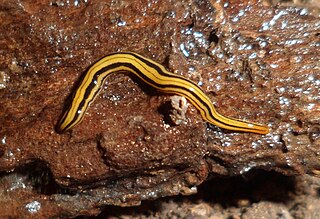
Luteostriata is a genus of land planarians from Brazil characterized by a yellow body with dark longitudinal stripes.

The reproductive system of planarians is broadly similar among different families, although the associated structures can vary in complexity.

Pasipha is a genus of land planarians from South America.
Eudóxia Maria Froehlich was a Brazilian zoologist.

Imbira guaiana is a species of land planarian in the subfamily Geoplaninae. It is the type species of the genus Imbira and is found in Brazil.

Luteostriata graffi is a species of Brazilian land planarian in the subfamily Geoplaninae.

Luteostriata ernesti is a species of Brazilian land planarian in the subfamily Geoplaninae.

Luteostriata ceciliae is a species of Brazilian land planarian in the subfamily Geoplaninae.

Supramontana irritata is a species of Brazilian land planarian in the subfamily Geoplaninae. It is the type species of the genus Supramontana.
Epiperipatus barbadensis is a species of velvet worm in the Peripatidae family, first described based on specimens from Barbados. It is one of the velvet worms that most often is kept in captivity, and was the first member of the Peripatidae family to be successfully maintained by hobbyist invertebrate keepers; it is easier to keep than the majority of other velvet worm species that have been tried, but still has specialized requirements that resemble those necessary for keeping poison dart frogs. E. barbadensis is social, nocturnal and viviparous, can live for several years, and feeds on small invertebrates that are caught by ejecting an adhesive slime from glands on their head.
Timyma is a genus of land planarians from Chile. It is the sole genus of the subfamily Timyminae.

Choeradoplana iheringi is a species of land planarian in the subfamily Geoplaninae found in Brazil.
Claudio Gilberto Froehlich was a Brazilian zoologist.
Cratera crioula is a species of land planarian belonging to the subfamily Geoplaninae. It is known from specimens found in Cantareira State Park, Brazil.
Paraba caapora is a species of land planarian belonging to the subfamily Geoplaninae. It is found within Brazil.
Choeradoplana banga is a species of land planarian belonging to the subfamily Geoplaninae. It is found in areas within the Atlantic Forest in Brazil, such as Cantareira State Park.
Choeradoplana gladismariae is a species of land planarian belonging to the subfamily Geoplaninae. It is found in areas within the Atlantic Forest in Brazil, such as the Intervales State Park.

Pasipha brevilineata is a species of land planarian belonging to the subfamily Geoplaninae. It is found within Brazil.
Pasipha variistriata is a species of land planarian belonging to the subfamily Geoplaninae. It is found within Brazil.

Pasipha backesi is a species of land planarian belonging to the subfamily Geoplaninae. It is found within Brazil.








